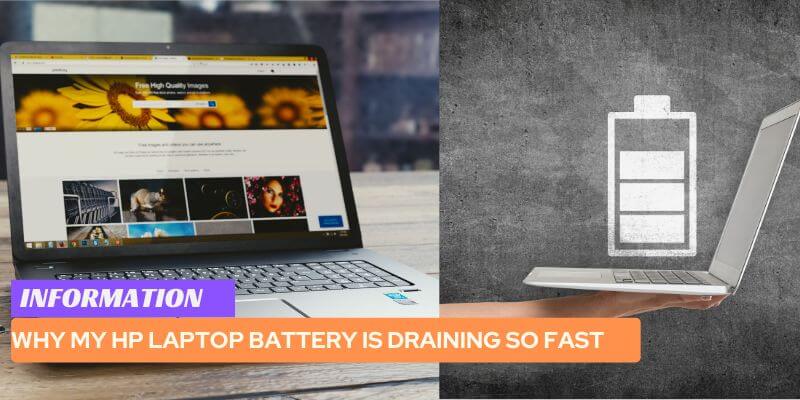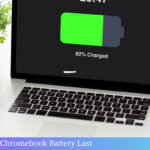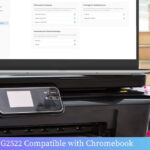The battery of an HP laptop may drain quickly due to various reasons, such as running power-hungry applications, outdated or faulty hardware, excessive background processes, display brightness settings, or improper power management settings. Is your HP laptop’s battery draining faster than usual?
It can be frustrating to constantly rely on a power source, especially when you need your laptop for work or entertainment.
Understanding why your laptop battery drains quickly is essential to fixing the issue and improving your battery life.
We will explore the common reasons why HP laptop batteries drain fast and provide some effective solutions to extend your battery life.
By the end, you’ll better understand how to optimize your laptop’s power consumption and keep it running longer without recharging.
So, let’s dive in and discover the potential causes behind your HP laptop’s rapid battery depletion.
Table of Contents
- Common Reasons For Fast Battery Drain
- Tip 1: Optimize Background Processes And Applications
- Tip 2: Adjust Screen Brightness And Display Settings
- Tip 3: Identify Power-hungry Apps And Software
- Tip 4: Maintain Battery Health And Longevity
- Tip 5: Optimize Power Settings
- Tip 6: Utilize Battery-saving Technologies
- Tip 7: Implement Good Charging Practices
Common Reasons For Fast Battery Drain
In this blog post, we will explore the common reasons why your HP laptop battery drains so fast.
Knowing what factors contribute to battery drain can help you optimize your laptop’s performance and extend its battery life. Let’s dive into the key reasons behind this issue.
1. Background Processes And Applications
The presence of numerous background processes and applications running on your laptop can significantly affect your battery life.
Many applications automatically run in the background, consuming valuable system resources and draining your battery.
You can use the Task Manager tool in Windows operating systems to identify these power-hungry applications.
It allows you to close unnecessary processes and applications draining your battery.
2. Screen Brightness And Display Settings
The brightness level of your laptop’s screen is another crucial factor contributing to fast battery drain.
Brighter screens consume more power. Adjusting your screen brightness to a comfortable level is recommended, yet not excessively optimistic.
Additionally, reducing the display timeout duration can help conserve battery power by automatically turning off the screen after a period of inactivity.
3. Power-hungry Apps And Software
Some applications and software are more power-hungry than others. Resource-intensive tasks like gaming, video editing, or running virtual machines can strain your laptop’s battery.
It’s essential to be mindful of the power requirements of your applications and close any unnecessary ones when not in use.
Alternatively, you can opt for energy-efficient alternatives or adjust the settings of power-hungry apps to reduce their impact on battery life.
4. Battery Age And Wear
Over time, laptop batteries naturally degrade and lose their capacity to hold a charge. If your laptop is several years old, it’s possible that the battery is not able to hold as much charge as it used to.
In such cases, replacing the battery might be the best solution. However, before doing so, it's advisable to validate the actual battery health through built-in diagnostics or consult a professional to ensure the battery is indeed the culprit of the fast battery drain.
5. Unoptimized Power Settings
Unoptimized power settings on your laptop can contribute to fast battery drain. For instance, unnecessarily enabling power-hungry features like Wi-Fi, Bluetooth, and keyboard backlighting can drain your battery.
It’s recommended to review your power settings and disable any features that are not required.
Adjusting the power plan settings in your laptop’s control panel allows you to customize power-saving options to maximize battery life.
Tip 1: Optimize Background Processes And Applications
Regarding laptop battery life, one common issue that many users face is fast draining. If you wonder why your HP laptop battery drains so fast, you’ve come to the right place.
In this article, we will explore some valuable tips to optimize background processes and applications, helping you extend your battery life.
1. Closing Unnecessary Applications And Processes
One effective way to optimize your HP laptop battery is by closing unnecessary applications and processes running in the background.
These applications can consume a significant amount of power, even if you’re not actively using them. By closing them, you can conserve battery life and enhance performance.
To close unnecessary applications:
- Press Ctrl + Shift + Esc to open the Task Manager.
- Navigate to the Processes tab.
- Identify the applications running and consuming a lot of CPU resources.
- Right-click on the application and select End Task to close it.
2. Managing Startup Programs
Another aspect to consider is managing the startup programs on your HP laptop. These programs automatically launch when you start your computer and can significantly impact battery life.
To manage startup programs:
- Press Ctrl + Shift + Esc to open the Task Manager.
- Go to the Startup tab.
- Review the list of programs and identify those that you don’t need to start automatically.
- Select the program and click Disable to prevent it from launching at startup.
3. Utilizing Battery-saving Modes And Settings
HP laptops offer various battery-saving modes and settings that can help optimize battery life.
By utilizing these features, you can extend your laptop's battery life and ensure efficient power usage.
To utilize battery-saving modes and settings:
- Click on the Battery icon in the system tray on your desktop.
- Select the Battery Saver mode to adjust settings and conserve battery power automatically.
- Customize power settings by clicking on Power & Sleep settings and adjusting options such as screen brightness and sleep mode.
By following these tips to optimize background processes and applications on your HP laptop, you can effectively preserve your battery life and ensure a longer-lasting and more efficient experience.
Remember to regularly close unnecessary applications, manage startup programs, and utilize battery-saving modes and settings for maximum benefit.
Tip 2: Adjust Screen Brightness And Display Settings
Is your HP laptop battery draining too quickly? One of the major culprits could be your screen brightness and display settings.
You can significantly extend your battery life and enjoy using your laptop for longer periods without worrying about running out of power by making a few adjustments.
1. Lowering Screen Brightness
One simple yet effective way to conserve battery power is by lowering your screen brightness. The brighter your screen, the more power it consumes.
To adjust your screen brightness:
- Click on the Start button and go to Settings in the bottom-left corner of your screen.
- In the Settings menu, select System and then click on Display.
- Scroll down to find the Brightness and Color section.
- Drag the Brightness slider to the left to lower the screen brightness.
By reducing your screen brightness to a comfortable level, you can significantly minimize the strain on your battery and help it last longer.
2. Enabling Automatic Brightness Adjustment
If manually adjusting your screen brightness seems like a hassle, you can enable the automatic brightness adjustment feature.
This feature allows your laptop to adapt the screen brightness based on ambient lighting conditions.
Here’s how to enable it:
- Open the Settings menu by clicking on the Start button and selecting Settings.
- Go to System and click on Display.
- Scroll down and toggle the switch next to Change brightness automatically when lighting changes to the “On” position.
Now, your laptop will automatically adjust the screen brightness according to the surrounding lighting, conserving battery power in the process.
3. Adjusting Power And Sleep Settings
In addition to screen brightness, optimizing power and sleep settings on your HP laptop is crucial for battery conservation.
By tweaking these settings, you can ensure your laptop operates efficiently without draining excessive power.
Follow these steps:
- Access the Settings menu by clicking on the Start button and selecting Settings.
- Choose System and click on Power & Sleep.
- Customize the power and sleep settings according to your preferences. For example, you can set your laptop to sleep after a certain period of inactivity or adjust the display timeout to conserve power.
By adjusting these settings, you can balance energy efficiency and usage convenience, maximizing your HP laptop’s battery life.
Tip 3: Identify Power-hungry Apps And Software
Is your HP laptop battery draining faster than usual? Don’t fret! One of the common culprits behind a rapidly draining battery can be power-hungry apps and software.
These resource-intensive applications can significantly strain your laptop’s battery life, causing it to deplete quickly.
You can optimize your battery usage and extend its lifespan by identifying and managing these power-hungry elements.
1. Monitoring Battery Usage In Task Manager
The first step in identifying power-hungry apps and software is to monitor your battery usage using the Task Manager.
This built-in Windows utility provides valuable insights into the programs and processes consuming the most power.
Here’s how you can access it:
- Press the Ctrl, Shift, and Esc keys together to open the Task Manager. Alternatively, you can right-click on the taskbar and select “Task Manager.”
- Once the Task Manager window opens, click on the “Processes” tab.
- Look for the “Power usage” column and click on it to sort the processes by power consumption. The highest power-consuming apps will appear at the top.
By monitoring battery usage in the Task Manager, you can identify which apps or programs are draining your battery the most.
This knowledge will guide you in taking appropriate measures to optimize your laptop’s performance.
2. Uninstalling Or Disabling Unnecessary Apps
Now that you have identified power-hungry apps and software, the next step is to uninstall or disable unnecessary ones.
These applications, which you may have installed but no longer use or need, can continue running in the background, consuming precious battery power.
Follow these steps to remove or disable them:
- Click on the Windows “Start” button and select “Settings.”
- In the Settings window, click on “Apps.”
- A list of installed apps will appear. Scroll through the list and identify any apps that you rarely use or don’t need.
- Click on the app and select “Uninstall”. Alternatively, you can click on “Advanced options” and disable the app.
- Repeat this process for all unnecessary apps.
By uninstalling or disabling unnecessary apps, you can minimize the power drain on your laptop’s battery, allowing it to last longer on each charge.
3. Updating Software And Drivers
Outdated software and drivers can be another reason behind your HP laptop’s fast-draining battery.
Manufacturers and developers often release updates to optimize performance, fix bugs, and improve power efficiency.
Here’s how you can update your software and drivers:
- Click on the Windows “Start” button and select “Settings.”
- In the Settings window, click on “Update & Security.”
- Click on “Windows Update” and check for any available updates. Install them if necessary.
- To update your drivers, click on “Device Manager.”
- Expand each category in the Device Manager window and right-click on the device. Select “Update driver.”
- Follow the on-screen instructions to update the drivers.
Updating your software and drivers ensures you have the latest optimizations and improvements, promoting better battery life on your HP laptop.
Tip 4: Maintain Battery Health And Longevity
1. Avoiding Extreme Temperatures
One crucial factor that impacts your HP laptop battery’s health and longevity is its exposure to temperature.
Extreme temperatures, whether too hot or too cold, can significantly decrease battery performance and drain it faster than usual.
When your laptop overheats, it affects the overall system performance and the battery life. High temperatures can cause the battery to lose its charge at a faster rate.
Therefore, keeping your laptop in a cool environment and avoiding exposing it to direct sunlight or placing it near heat sources such as radiators or hot air vents is essential.
Similarly, extremely cold temperatures can also negatively affect the battery’s performance. Suppose you live in a region with freezing temperatures.
In that case, it’s advisable to keep your laptop insulated and avoid leaving it in your car overnight or exposing it to icy conditions.
2. Calibrating The Battery
Calibrating your HP laptop’s battery periodically can help maintain its health and maximize its longevity.
Over time, the battery’s capacity may become inaccurate, leading to incorrect percentage readings and sudden power-offs.
To calibrate your battery, follow these steps:
- Charge your laptop’s battery to 100% while it is powered on.
- Once fully charged, keep the laptop connected to the charger for two more hours.
- After two hours, disconnect the charger and use your laptop until the battery drains completely.
- Once the battery is depleted, reconnect the charger and let it charge to 100% without interruption.
Calibrating your battery periodically allows the laptop’s power management system to recalibrate and provide accurate battery readings.
This can help prevent unexpected shutdowns and improve overall battery performance.
3. Regularly Updating The Laptop’s Firmware
Keeping your HP laptop’s firmware up to date is vital for maintaining battery health and optimizing performance.
Firmware updates often include improvements in power management algorithms, which can help regulate battery usage and extend its lifespan.
To ensure your laptop’s firmware is up to date, follow these steps:
- Visit the official HP support website.
- Search for your laptop model and navigate to the “Drivers and Software” section.
- Check for any available firmware updates specifically related to power management or battery optimization.
- If updates are available, download and install them according to the instructions.
Regularly updating your laptop’s firmware enhances battery life and improves overall system stability and security, ensuring you have the latest features and bug fixes.
Tip 5: Optimize Power Settings
If you’re wondering why your HP laptop battery is draining so fast, one effective solution is to optimize your power settings.
By adjusting various power options and enabling power-saving features, you can significantly extend your laptop’s battery life.
1. Changing Power Plan Settings
One way to optimize power settings is by changing your power plan settings. Windows provides different power plans, such as Balanced, Power Saver, and High Performance.
Each plan has its own settings that control how your laptop utilizes power.
To modify your power plan settings:
- Click on the battery icon in the system tray and select “Power Options.”
- Choose the power plan you wish to customize.
- Click on “Change plan settings” to access the advanced settings for that particular plan.
- Adjust the settings according to your preferences, such as setting a shorter duration for turning off the display or putting the laptop to sleep.
- Save your changes to apply the optimized power plan settings.
2. Customizing Power Options For Specific Apps
Another helpful way to optimize power settings is by customizing power options for specific apps.
Some applications may consume more power than others, leading to faster battery drain. By tailoring power options for these apps, you can ensure they operate energy-efficiently.
Here’s how you can customize power options for specific apps:
- Open the “Control Panel” and click on “Hardware and Sound.”
- Select “Power Options.”
- Click on “Change plan settings” next to your preferred power plan.
- Choose “Change advanced power settings.”
- In the advanced power settings window, find the “Multimedia settings” and expand it.
- Adjust the settings for specific apps that tend to consume more power, such as reducing the maximum processor state or limiting the video playback quality.
- Click on “Apply” and then “OK” to save the changes.
3. Enabling Power-saving Features
To further optimize your HP laptop’s power settings, it’s essential to enable power-saving features.
These features automatically adjust system settings to conserve battery life when idle or during low-power consumption tasks.
You can enable power-saving features by:
- Clicking on the battery icon in the system tray and selecting “Power Options.”
- Choosing the power plan you wish to modify.
- Click on “Change plan settings” to access the advanced settings.
- Scroll down to find the power-saving features section.
- Enabling features like “Dim the display” or “Put the computer to sleep” after a specific duration of inactivity.
- Click on “Save changes” to apply the power-saving features.
You can effectively extend your HP laptop’s battery life by optimizing power settings, changing power plan settings, customizing power options for specific apps, and enabling power-saving features.
Try implementing these practices to enjoy longer and more productive battery cycles!
Tip 6: Utilize Battery-saving Technologies
1. Utilizing Battery-saving Modes
One of the most effective ways to extend the battery life of your HP laptop is by utilizing battery-saving modes.
These modes are specifically designed to optimize your laptop’s power consumption, ensuring that you get the most out of your battery.
To access battery-saving modes on your HP laptop, follow these simple steps:
- Click on the battery icon in the system tray at the bottom right corner of your screen.
- Select “Power Options” from the dropdown menu.
- In the Power Options window, you will find various power plans such as Balanced, Power Saver, and High Performance.
- Choose the Power Saver option to maximize your laptop’s battery life. This mode reduces the display’s brightness and adjusts other power settings to conserve energy.
By utilizing the power-saving modes, you can significantly reduce the strain on your laptop’s battery, allowing it to last longer between charges.
2. Using External Battery Packs Or Power Banks
When you find yourself in situations where you need to use your HP laptop for an extended period without access to a power source, using external battery packs or power banks can be a lifesaver.
These portable charging solutions come in various capacities. They can provide an additional power source for your laptop on the go.
Connect the external battery pack or power bank to your laptop via the USB port or other compatible charging ports, and it will start charging your laptop’s battery.
When choosing an external battery pack or power bank, take note of the capacity and compatibility with your HP laptop to ensure optimal performance.
Additionally, consider the charging speed and portability of the device, as these factors can make a difference in your overall convenience.
3. Considering Energy-efficient Hardware Upgrades
Suppose your HP laptop is experiencing rapid battery drain despite utilizing battery-saving modes. In that case, it may be worth considering energy-efficient hardware upgrades.
Upgrading certain laptop components, such as the processor, graphics card, or battery itself, can significantly improve power efficiency and extend battery life.
Remember that not all components may be easily replaceable or compatible with your specific laptop model when upgrading your hardware.
It is recommended to consult with an HP technician or refer to the official HP website for guidance on compatible upgrades.
Investing in energy-efficient hardware upgrades can provide long-term benefits by reducing power consumption and ensuring your laptop’s battery lasts longer between charges.
Tip 7: Implement Good Charging Practices
One of the key factors contributing to a fast-draining battery on your HP laptop is poor charging practices.
You can optimize the battery life and prevent unnecessary drainage by implementing good charging habits. Here are a few tips to follow:
1. Avoiding Constant Charging
While it may seem convenient to keep your laptop plugged in at all times, constant charging can actually harm the battery’s health in the long run.
This is because lithium-ion batteries, which are commonly used in laptops, have a finite lifespan.
The more you use them, the faster they degrade. Therefore, it’s important to avoid keeping your laptop plugged in constantly.
When you’re not using your laptop, disconnect the charger. This will allow your battery to discharge and cycle through its capacity, which helps maintain overall battery health.
Additionally, if you’re using your laptop for extended periods, it’s a good idea to unplug the charger once the battery reaches around 80% to prevent overcharging.
2. Ensuring Proper Charging Cable And Adapter Usage
Using the correct charging cable and adapter is crucial for maintaining your laptop’s battery health. HP laptops usually come with a specific charger designed for optimal performance.
Using a different or third-party charger may not provide the necessary power output, leading to improper charging and potential battery drainage.
Always make sure to use the original charger that came with your laptop. If you’ve lost it or it’s not functioning correctly, purchase a genuine HP replacement charger to ensure compatibility.
Avoid using cheap or counterfeit chargers, as these can cause damage to both the battery and the laptop itself.
3. Keeping The Battery Between 20-80% Charge
Did you know how you charge your laptop can impact its battery life? Keeping your battery within the desired charge range of 20-80% can help prolong its lifespan and minimize battery drainage.
This is because lithium-ion batteries are designed to operate optimally within this range.
Avoid letting your laptop’s battery level drop below 20% or charging it fully 100% unless necessary.
Constantly depleting the battery to extremely low levels or keeping it fully charged for long periods can lead to accelerated battery degradation.
To maintain a healthy charge level, try to charge your laptop when the battery level drops to around 20% and unplug it once it reaches 80%.
This way, you’ll ensure your battery stays within the recommended range, maximizing its longevity and minimizing drainage.
Frequently Asked Questions Of Why My HP Laptop Battery Is Draining So Fast
How Do I Fix My Laptop Battery From Draining Fast?
To fix a laptop battery that drains fast, try these steps:
1. Adjust power settings by reducing screen brightness and disabling unnecessary apps.
2. Close unused programs and tabs to conserve battery life.
3. Remove external devices that drain power when not in use.
4. Update your operating system and drivers to optimize battery performance.
5. Consider replacing the battery if it’s old or damaged.Why Does My HP Battery Drain Fast?
HP batteries may drain fast due to several factors, such as running power-hungry applications, outdated software, excessive screen brightness, or background processes. Adjusting power settings, closing unnecessary apps, updating software, and reducing screen brightness can help improve battery life.
How Long Should HP Laptop Battery Last?
The battery life of an HP laptop typically lasts for several hours, depending on usage. It can range from 4 to 12 hours, varying according to the specific model and settings.
Is 2 Hours Of Battery Life Good For A Laptop?
Yes, 2 hours of battery life is considered a good amount for a laptop. It allows for portability and use while away from a power source.
Why Is My HP laptop Battery Draining So Fast?
There are several reasons why your HP laptop battery may be draining fast, such as running heavy programs, outdated drivers, and battery calibration issues.
How Can I Prolong The Battery Life Of My HP Laptop?
To prolong the battery life of your HP laptop, you can adjust power settings, lower screen brightness, close unnecessary programs, and keep your laptop cool.
What Should I Do If My HP Laptop Battery Is Not Charging?
If your HP laptop battery is not charging, try unplugging and re-plugging the charger, checking the power outlet, and updating battery drivers.
Can Use Certain Software Drain My HP Laptop Battery Faster?
Yes, certain software and programs that require high processing power can drain your HP laptop battery faster.
Is It Normal For A Laptop Battery To Drain While It’s In Sleep Mode?
Yes, it is normal for a laptop battery to drain slowly while in sleep mode, as some background processes still run.
How Often Should I Calibrate My HP Laptop Battery?
It is recommended to calibrate your HP laptop battery every 2-3 months to ensure accurate battery level readings.
Conclusion on Why My HP Laptop Battery Is Draining So Fast
After examining the potential reasons why your HP laptop battery drains so quickly, it is essential to take action to resolve the issue.
By implementing the strategies mentioned in this blog post, such as adjusting your power settings, managing background applications, and optimizing battery usage, you can maximize your laptop’s battery life.
Remember, staying aware of these factors and taking preventive measures will help you enjoy longer battery life and uninterrupted productivity.






